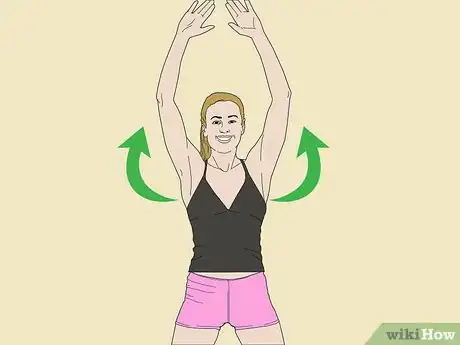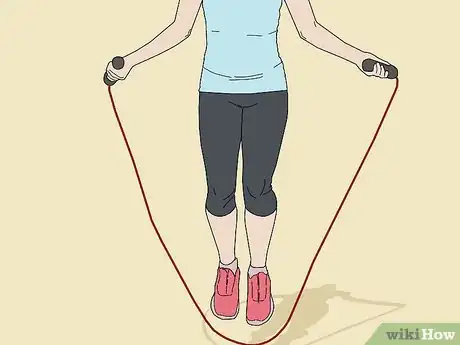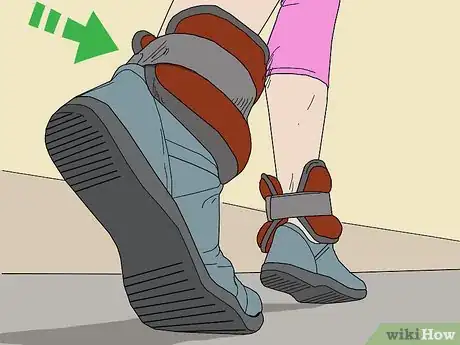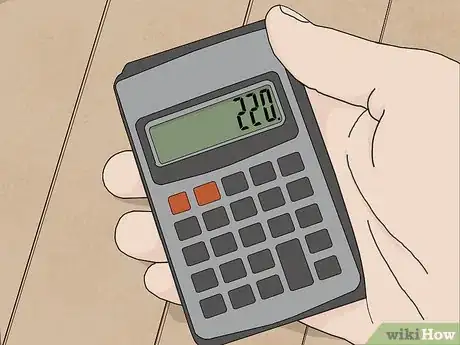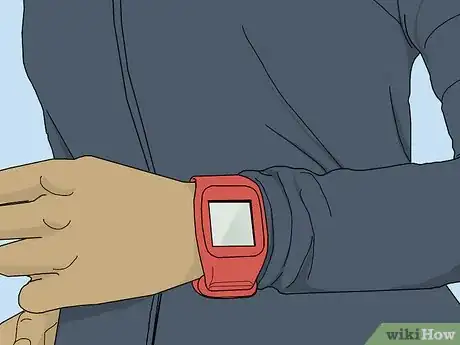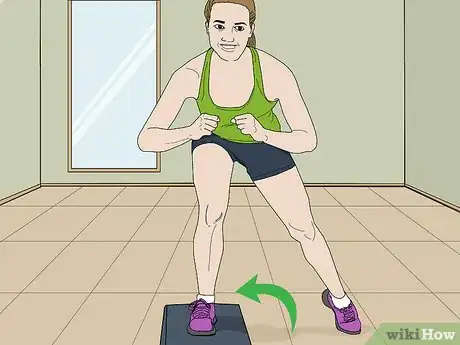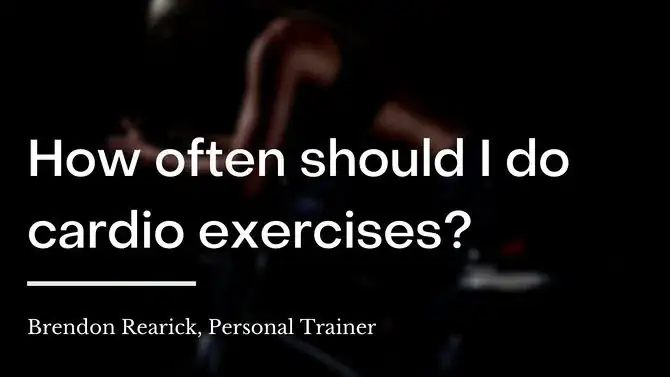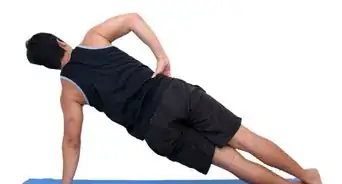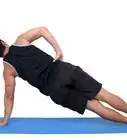This article was co-authored by Pete Cerqua. Pete Cerqua is a Certified Personal Trainer and Nutritionist. Pete is also a five-time best-selling author of books including "The 90-Second Fitness Solution" and "High Intensity Fitness Revolution for Women/Men" published by Simon and Schuster and Skyhorse Publishing. Pete has over 20 years of personal training and nutrition coaching experience and operates the 90-Second Fitness flagship studio in New York City.
There are 12 references cited in this article, which can be found at the bottom of the page.
This article has been viewed 95,457 times.
Cardiovascular, or cardio, exercise is a great way to boost your heart rate and improve overall blood flow. It’s best to aim for 30-45 minutes of moderate to vigorous aerobic exercise at least 3 times per week. Running, swimming, or cycling all count as cardio exercise. As with any workout, it’s important to go slowly and to pay attention to the limitations of your body when starting out. You can add cardio to an existing workout program or take an entirely new class.
Steps
Incorporating Cardio into Your Daily Life and Workout
-
1Consult your doctor if you suffer from any chronic health problems. Before you make any major changes to your exercise routine, such as adding cardio, it is a good idea to discuss these with your doctor. If you suffer from joint or back pain, diabetes, or heart disease, there may be certain cardio exercises that you should avoid.[1]
- Your doctor might suggest completing your first few new exercises with a personal training professional, just to make sure that everything is okay.
-
2Start a walking schedule. Depending on your health level, begin by walking just 5 or so minutes around the block or on a treadmill. Then, add an extra minute each day until you reach 10 minutes. At that point, assess your pace to make sure that you are moving briskly and with a purpose. Continue to add minutes until you have a 30-45 minute walking plan in place.[2]Advertisement
-
3Swim laps at a local pool or gym. Start your swimming workout with the backstroke. Position yourself on your back in the water and rotate your arms up over your head and through the water. Then, move on to the breaststroke or even using a kickboard. Try to swim for 10 minutes during your first session and build up from there.[3]
-
4Run around your neighborhood. The first time that you run, keep going until your legs start to feel tired and sluggish. Note your time and try to increase it slightly with each additional cardio session. Maintain good form when you are running by keeping your shoulders back and raising your feet well off the ground.[4]
-
5Try out cycling. You can either use a bike machine at your local gym or hit the streets/trails with a bicycle. Don’t try to go too long during your first session. Aim for a 15-30 minute ride. A recumbent bike machine, which allows you to fully sit down, will be easiest to start with if you are worried about pacing.
-
6Perform cardio in between weight sets. This is one of the best ways to make the most of a 45-60 minute workout. After each set, do 2-3 minutes of a quick cardio routine, such as jumping jacks or sprints. This cardio exercise essentially takes the place of your rest periods and keeps your heart rate elevated.[5]
- This approach is a good one if you are trying to break through an exercise plateau.
-
7Jump rope at the beginning and end of your workout session. Get a rope and then warm up by hopping up and down with both feet close together. Then, concentrate on hopping at a slight angle from side-to-side, so that your feet don’t land in the same place. You can also pull your knees up high when jumping for a little extra muscle burn.[6]
- Try double unders for a great cardio workout when jumping rope.
-
8Add in cardio by taking the stairs if you don’t have time for a formal workout. This a great way to burn some extra calories during a busy day. Aim to walk or jog up a single floor and then increase your floor goals over time as you get more fit. Stair walking is a great workout because you are essentially moving your own body weight at a continual vertical angle.
Maximizing Your Cardio Impact
-
1Wear athletic clothing and comfortable shoes. If you are doing cardio, you may place added pressure onto your feet, especially if you are jumping up and down or running. Buy and wear shoes that have strong cushions and arch supports. If you sweat a bit while working out, getting lightweight clothing can leech the moisture away and make you feel more comfortable during cardio.
-
2Stretch thoroughly after a cardio workout. Take the time to stretch all the major muscle groups that you work during the cardio exercise. Do a few high kicks or hip circles. You can even do 5 minutes on the elliptical machine before moving on to your main cardio. Stretching properly can help prevent injury and also ensures continued mobility, range of motion, and flexibility.[7]
-
3Increase the length of your cardio sessions over time. If you are new to cardio exercises, it’s important that you start off slowly. Add 10-15 minutes of cardio to your existing workout routine. Then, try to add on an extra 5 minutes each week. Your goal should be to build up to around 30-45 minutes of cardio per workout session.[8]
- The same rule applies to the intensity of your cardio workouts. For example, don’t just jump right into running a mile. Instead, start out by walking with short sprints mixed in.
-
4Do cardio with small weights included. There are hand or wrist weights that you can buy to wear while working out. These 1-5 lb. (0.5 to 2.5 kg) weights are light enough to not encumber your movements, but heavy enough to increase the difficulty of your workout. You can wear them while walking or running on the treadmill or while jumping rope.
- Avoid wearing wrist or ankle weights for longer than 5-10 minutes at a time. Wearing them for extended periods can result in damage to connective tissues like tendons and ligaments.
-
5Figure out your target moderate heart rate. Pull out a calculator or a piece of paper and start with the number 220. Then, subtract your age. Multiply that result by 0.70 and the final number is your ideal target heart rate. This calculation works best for people who are new to cardio. If you are used to working out at a high intensity, then replace 0.70 with 0.80 or 0.90 at that stage.[9]
- For example, if you are 35 years old, you’ll subtract 35 (your age) from 220. You’ll get 185 (your target heart rate), which you will then multiply by 0.70 (for a moderate target). This shows that your target heart rate is 129.50 beats per minute.
- Remember that 220 beats per minute is considered the fastest human hearts are capable of beating, and is close to an infant's heart rate.
-
6Wear a heart rate monitor on your wrist. There are many different types of heart rate monitors that you can purchase and wear. Some are pretty basic and will simply give you a heart rate readout, whereas others will also calculate burned calories. Follow your device’s directions carefully in order to guarantee an accurate read-out. Then, wear and read your monitor while working out, so that you’ll know when you hit your target.[10]
Taking Exercise Classes
-
1Take a spinning class. Check to see if your local gym or community center offers a spinning class. Or, go to a cycling center. In these classes all of the participants will have their own bikes and will follow the directions of an instructor at the front of the room. The routines usually last between 30-60 minutes and start off slowly before building momentum.[11]
- Most spin sessions include a series of sprints followed by cool down periods.
- Some spin classes even have a video or music element.
-
2Enroll in a step class. During a step aerobics class, you’ll step up, down, and around a 4 to 12 inches (10 to 30 cm) raised platform. You’ll use different patterns to strengthen your muscles and ratchet up your heart rate. Many gyms offer step classes that last 30-60 minutes in which an instructor shows you the pattern to follow.[12]
-
3Sign up for a boot camp. Most of these camps are organized according to a military model with a series of interval moves. In a 30-60 minute class you might do jumping, push-ups, squats, or sprints. Most boot camps run between 3-6 weeks with meetings between 1-3 times per week. Personal trainers offer camps as well as gyms and community centers.[13]
-
4Take a water aerobics or water jogging class. This is a great option if you have a knee or leg injury and are trying to reintroduce cardio. These classes take place in a pool at a gym or community center. They usually last between 45-60 minutes. When you are in the water you’ll practice running or jumping while wearing or carrying weights.
-
5Try Zumba. Zumba is a dance workout set to Latin American music. Many recreation and community centers offer Zumba classes. During these classes, an instructor will show you dance moves that alternate between high- and low-intensity to get your heart rate up. The classes often last 60 minutes. Zumba is a fun way to get cardio exercise without it feeling like work.[14]
Expert Q&A
Did you know you can get expert answers for this article?
Unlock expert answers by supporting wikiHow
-
QuestionHow often should I do cardio exercises?
 Brendon RearickBrendon Rearick is a Personal Trainer, Strength Coach, Fitness Program Director, and co-founder of Certified Functional Strength Coach (CSFC), a fitness education company in the San Francisco Bay Area. With 17 years of experience in the fitness industry, Brendon specializes in strength and conditioning, and his company CSFC has certified over 3,000 trainers in over 20 countries. Brendon has worked as a Program Director for Mike Boyle Strength and Conditioning (MBSC) and earned his massage therapy license from the Cortiva Institute-Boston. Brendon holds a BS in Kinesiology from the University of Massachusetts Amherst.
Brendon RearickBrendon Rearick is a Personal Trainer, Strength Coach, Fitness Program Director, and co-founder of Certified Functional Strength Coach (CSFC), a fitness education company in the San Francisco Bay Area. With 17 years of experience in the fitness industry, Brendon specializes in strength and conditioning, and his company CSFC has certified over 3,000 trainers in over 20 countries. Brendon has worked as a Program Director for Mike Boyle Strength and Conditioning (MBSC) and earned his massage therapy license from the Cortiva Institute-Boston. Brendon holds a BS in Kinesiology from the University of Massachusetts Amherst.
Personal Trainer & Strength Coach
-
QuestionShould I add cardio to my workout?
 Pete CerquaPete Cerqua is a Certified Personal Trainer and Nutritionist. Pete is also a five-time best-selling author of books including "The 90-Second Fitness Solution" and "High Intensity Fitness Revolution for Women/Men" published by Simon and Schuster and Skyhorse Publishing. Pete has over 20 years of personal training and nutrition coaching experience and operates the 90-Second Fitness flagship studio in New York City.
Pete CerquaPete Cerqua is a Certified Personal Trainer and Nutritionist. Pete is also a five-time best-selling author of books including "The 90-Second Fitness Solution" and "High Intensity Fitness Revolution for Women/Men" published by Simon and Schuster and Skyhorse Publishing. Pete has over 20 years of personal training and nutrition coaching experience and operates the 90-Second Fitness flagship studio in New York City.
Certified Personal Trainer & Nutritionist Absolutely, cardio is good for you. I think a lot of people tend to assume that cardio is only running, though. Anything that gets your heart rate up without any resistance element technically counts as cardio. That would include a lot of callisthenic exercises and whatnot. Even daily chores will get your heart rate up.
Absolutely, cardio is good for you. I think a lot of people tend to assume that cardio is only running, though. Anything that gets your heart rate up without any resistance element technically counts as cardio. That would include a lot of callisthenic exercises and whatnot. Even daily chores will get your heart rate up. -
QuestionWhat is the best way to increase your cardio?
 Pete CerquaPete Cerqua is a Certified Personal Trainer and Nutritionist. Pete is also a five-time best-selling author of books including "The 90-Second Fitness Solution" and "High Intensity Fitness Revolution for Women/Men" published by Simon and Schuster and Skyhorse Publishing. Pete has over 20 years of personal training and nutrition coaching experience and operates the 90-Second Fitness flagship studio in New York City.
Pete CerquaPete Cerqua is a Certified Personal Trainer and Nutritionist. Pete is also a five-time best-selling author of books including "The 90-Second Fitness Solution" and "High Intensity Fitness Revolution for Women/Men" published by Simon and Schuster and Skyhorse Publishing. Pete has over 20 years of personal training and nutrition coaching experience and operates the 90-Second Fitness flagship studio in New York City.
Certified Personal Trainer & Nutritionist
Warnings
- Pay close attention to how your body is reacting to the addition of cardio. If you feel like you need a break, take one. Ignoring your body could result in a lasting injury.⧼thumbs_response⧽
References
- ↑ https://www.mayoclinic.org/healthy-lifestyle/fitness/in-depth/exercise/art-20047414
- ↑ Pete Cerqua. Certified Personal Trainer & Nutritionist. Expert Interview. 14 May 2020.
- ↑ https://www.mensfitness.com/training/cardio/plunge-cardio-how-swim-calories
- ↑ Pete Cerqua. Certified Personal Trainer & Nutritionist. Expert Interview. 14 May 2020.
- ↑ https://www.muscleandfitness.com/workouts/workout-tips/6-ways-sneak-cardio-your-workouts
- ↑ https://www.shape.com/fitness/cardio/jump-rope-workout-blast-fat-20-minutes?crlt_pid=camp.7HP2sOhfQoeJ
- ↑ https://www.bu.edu/today/2015/stretch-before-exercise-not-so-fast/
- ↑ Pete Cerqua. Certified Personal Trainer & Nutritionist. Expert Interview. 14 May 2020.
- ↑ https://www.mayoclinic.org/healthy-lifestyle/fitness/in-depth/exercise-intensity/art-20046887?pg=2
- ↑ https://www.health.harvard.edu/heart-health/how-to-choose-and-use-a-heart-rate-monitor-
- ↑ https://totalwomenscycling.com/fitness/11-things-know-first-spin-class
- ↑ https://www.webmd.com/fitness-exercise/a-z/step-aerobics
- ↑ https://www.active.com/fitness/articles/the-benefits-of-bootcamp
- ↑ https://www.webmd.com/fitness-exercise/a-z/zumba-workouts
About This Article
If you’d like to add cardio exercises to your workout, jump rope before your workout sessions to elevate your heart rate while warming up. To make jumping rope effective, start by hopping up and down keeping your feet close together, then increase the intensity by lifting your knees up high while jumping. During workouts, such as weight sets, add jumping jacks or sprints between your sets in place of rest periods, to keep your heart rate elevated. And if you want your whole workout to be based on cardio exercise, try swimming, running or cycling, since these are full cardio workouts. Whatever you choose, if you’re new to cardio workouts, always start off slowly by adding 10-15 minutes of cardio first, then gradually building up to 30-45 minutes of cardio a session. For more tips from our Personal Training co-author, including how to monitor your heart rate, read on!






